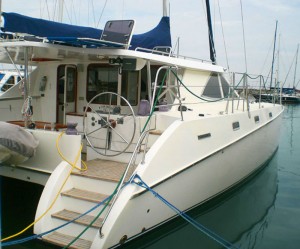Manufacturing ‘renaissance’ in Philippines seen

A Philippine-made catamaran sailing yacht made by Ces Craft Philippines. The Philippines may be on the brink of a manufacturing “renaissance” that can add a leg to its structural growth story, says the German financial giant Deutsche Bank, citing the breadth of industries from tires to boats that are expanding capacities. PHOTO FROM BOATSHOPMANILA.COM
After decades of reliance on remittances and the business process outsourcing sector, the Philippines may be on the brink of a manufacturing “renaissance” that can add a leg to its structural growth story, according to German financial giant Deutsche Bank.
In a report titled “Manufacturing: A New Growth Driver” issued last week, the bank said it remained “structurally bullish” on the Philippine economy specially as the investment cycle “seems to have turned sustainably upward.” While most bets are on the government’s public-private partnership (PPP) infrastructure to be the linchpin of an investment-led growth, the research paper raised the possibility that manufacturing—which remained “under the radar” despite an evidence of a surge since 2010—could be a key driver as well.
As a share of gross domestic product, industry peaked at 43 percent in the early 1980s falling to 31 percent in the first semester of 2012—a low level not seen since the 1950s, the report noted. On the other hand, services fueled by remittances and BPOs contributed nearly 60 percent, in turn driving consumption higher.
“But evidence points to a nascent surge in the manufacturing sector—a renaissance of sorts. More startling, the growth seems to be coming from the export sector. In fact, an objective reading of the data suggests the rebound has been happening for at least two years now,” said the September 24 research authored by analysts Rafael Garchitorena, Carissa Manhubat and Iza Fernandez.
Deutsche Bank pointed out that loan growth, electricity and water usage and even exports have consistently shown strong industrial growths since 2010. It also favorably noted that investment commitments in export zones hit new all-time highs in 2011, suggesting further demand growth as the plants are completed.
“And the breadth of industries is impressive. Makers of everything from tires, chemicals, capacitors, printers, toys, lenses, boats, ignition wire harnesses and airline galleys are expanding capacity,” the research said.
It was often argued in the past that high labor and power costs and poor infrastructure were making the country uncompetitive in manufacturing, thus skewing the economy toward services.
According to Deutsche Bank, labor costs have been “remarkably stable” in the Philippines, with minimum wage growth of just 5 percent annually in the last decade compared to the sharp increases in Thailand and China wages, making the English-speaking Filipino worker “much more competitive by default.” It said the recent 40-percent increase in Thai wages, for example, had brought the premium of Metro Manila wages (at about $10.68 a day) over Bangkok (at about $9.72 a day) to just 10 percent. Bangkok and Shanghai minimum wages are now about the same as, or more expensive than, in areas just outside Manila.
On power costs, the research said while these remained the highest in the region, some firms operated during off-peak hours when rates were lower. It also pointed out that companies operating in Philippine Economic Zone Authority-accredited zones were exempt from a variety of taxes, which could lower their electricity costs by another 10 percent and further narrow the price differential. Finally, it argued that with the upcoming implementation of “open access”—wherein large electricity users could negotiate supply contracts directly with power generators and aggregators—electricity rates could go down further.
On infrastructure, the research said that while it was true that the Philippines was suffering from poor internal infrastructure, it is an archipelago and, as such, had many sea ports across the country. It also noted the incentives offered by Peza for manufacturing, including duty-free importation of capital equipment and raw materials, three- to eight-year corporate income tax holidays and value-added tax exemption for local purchases.
Meanwhile, the research noted that the key downside risk to the manufacturing sector’s competitiveness was the strong peso.
Overall, the study said a prospective manufacturing “renaissance” could add another leg to the Philippine stock market’s bull story and benefit banks, power, property and consumption the most.
While it said there were few direct plays on a resurgent manufacturing sector, Deutsche Bank’s top pick for the theme was Manila Electric Co., the country’s biggest power distributor.
